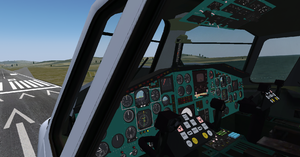Tupolev Tu-144D
Jump to navigation
Jump to search
 Tu 144 preparing for takeoff | ||
| Type | Airliner, Supersonic aircraft | |
|---|---|---|
| Configuration | Canard aircraft, Delta-wing aircraft | |
| Propulsion | Quadjet (Jet aircraft, Four-engine aircraft) | |
| Manufacturer | Tupolev | |
| Author(s) | @femboywings, @ShFsn, @konsni | |
| FDM | JSBSim | |
| --aircraft= | Tu-144D | |
| Status | Advanced production | |
| FDM |
| |
| Systems |
| |
| Cockpit |
| |
| Model |
| |
| Supports |
| |
| Development | ||
| Repository |
| |
| Download |
| |
| License | CC BY-SA 4.0 | |
| ||
| Wikipedia |
Tupolev Tu-144 | |
|
| ||
The Tupolev Tu-144 (NATO: Charger) supersonic transport (SST) was the first of the two supersonic passenger airliners to fly. The other one was the Concorde.
The aircraft is unique for its retractable canards, which enable takeoff/landing at speeds not much higher than those of conventional airliners.
FlightGear model
The project was conceived in July 2014 and has been active since April 2015. Its goal is to accurately model flight dynamics, systems and instruments of the Tu-144 entirely in JSBSim.
catalog.xml for the QT launcher: https://gitlab.com/mdanil/Tu-144_hangar/raw/master/catalog.xml
Current status
May 2019.
- visual converted from FSX with due care;
- DATCOM FDM with experimental aeroservoelastics and ground effect;
- control in agreement with POH;
- reasonable autopilot based on the documentation for Tu-154B;
- plausible navigation stack with the Orbita-10 FMC, RSBN support, mobile RSBN and mobile Katet landing system;
- complete set of cockpit warnings;
- engines, systems and most instruments following POH;
- automated crew: callouts and landing/RTO actions;
- state overlays and realistic autostart;
- correct animation, sounds, view and particle effects in multiplayer;
- basic damage;
- visibility of Su-15 MPClash missiles;
- Mumble control;
- Autopush automatic pushback.
Known issues
- much of the cockpit is still only represented by PUI dialogs;
- most of the completed panels have no text.
Characteristics and performance
| Weight | |
|---|---|
| Empty | 99,200 kg |
| Max T/O | 207,000 kg |
| Normal T/O | < 180,000 kg |
| Max landing | 132,000 kg |
| Fuel max | 98,000 kg |
| Payload max | 15,000 kg |
| Speed | |
| Cruise | Mach 1.9..2.1 |
| Max at 19,000 m | Mach 2.15 |
| Pattern | 340 km/h IAS (~ 350 km/h TAS) |
| Approach | 290 km/h IAS (~300 km/h TAS) |
| Altitude | |
| Cruise | 16,500..19,500 m |
| Practical ceiling | 19,700 m |
| Range | |
| Max fuel, 7,000 kg payload | 6500 km |
External links
| ||||||||